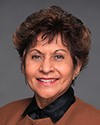Thank you, Madam Chair.
Mr. Lindsay or Ms. Townson, you referred earlier to women who had to return home in order to look after their family members. I believe that this has already begun.
I am part of what we refer to as the sandwich generation. There are two generations preceding us and two that follow us. Up until two years ago, I looked after my grandmother, who is 94 years old. I look after my mother, who is 78 years old. I have a hemophiliac son who is 36 years old and I have a 14-year-old grandson, who is in my custody. Women are always there, right?
The fact is that no mention is made about the silent women, the ones with no income, with no cheques and with no fixed address, and these are the ones who worry me the most. There is a growing number of these women in our large centres. Do you know how many women fall under this category now, how can we reach them and what we can do to help them become part of the workforce, in other words, the labour market? Have any studies on this issue been done?
It is appalling to see all these women in these situations. There are many aboriginal women, but also many other women who come from various backgrounds. Given the number of women who don't receive any cheques or income and have no access to a job, I think that the statistics on unemployment are really skewed. If there are a million poor children in Canada, it is because they have poor parents.






